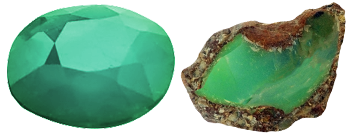 Photo of Chrysoprase in Processed & Rough Form
Photo of Chrysoprase in Processed & Rough Form
Chrysoprase is a mineral with a hardness of 7 out of 10 on the Mohs scale of mineral hardness [?]. These Trigonally structured gems are made of silicon dioxide, their full chemical compound being SiO2.
Chrysoprase is a massive, translucent, dull leek-green to yellow-green compact quartz aggregate, a variety of chalcedony.
It is a crystalline quartz leek-green in color containing swarm of green hair-like fibers amphibole actinolite, which is responsible for green color. Its color is caused by fibrous ferrohornblende aggregates or disseminated chlorite minerals. The stone is more translucent than plasma. It is frequently called green agate. It is also called mother-of-emerald. Sometimes spelled prasius.
European deposits are in East Germany (Ore mountains), Finland, Austria (near Salzburg) and Scotland.
Vermont and Pennsylvania have deposits of prase, and the material is found worldwide. The name buddstone has been given to a green chlorite-rich chalcedony with white veining, found in southern Africa.
Sometimes green jasper is called prase. It can also be confused with jade.
The specific gravity [?] for Chrysoprase is 2.61, it's refractive index [?] is 1.53-1.54, and it's double refraction [?] is 0.004.
History
Prase derives its name from the Greek word meaning "leek."
Industrial Usages
All varieties of chalcedony are cut into cabochons, engraved, or made into seal stones or rounded, polished and pierced for necklaces or other items of jewelry. Various forms were used extensively for bases and handles of gold items (statuettes, goblets, cruets) and for stone inlay work. Prase makes excellent material for cameos.








